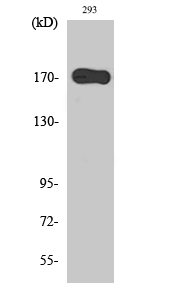EGFR Polyclonal Antibody
For reference only. Please follow the manual included in your kit for instructions.
Catalog Number
RD231285A
Product Name
EGFR Polyclonal Antibody
Catalog Number
RD231285A
Clonality
Polyclonal
Purification Method
Affinity purification
Isotype
IgG
Host
Rabbit
Background
Receptor tyrosine kinase binding ligands of the EGF family and activating several signaling cascades to convert extracellular cues into appropriate cellular responses. Known ligands include EGF, TGFA/TGF-alpha, amphiregulin, epigen/EPGN, BTC/betacellulin, epiregulin/EREG and HBEGF/heparin-binding EGF. Ligand binding triggers receptor homo- and/or heterodimerization and autophosphorylation on key cytoplasmic residues. The phosphorylated receptor recruits adapter proteins like GRB2 which in turn activates complex downstream signaling cascades. Activates at least 4 major downstream signaling cascades including the RAS-RAF-MEK-ERK, PI3 kinase-AKT, PLCgamma-PKC and STATs modules. May also activate the NF-kappa-B signaling cascade. Also directly phosphorylates other proteins like RGS16, activating its GTPase activity and probably coupling the EGF receptor signaling to the G protein-coupled receptor signaling. Also phosphorylates MUC1 and increases its interaction with SRC and CTNNB1/beta-catenin.Isoform 2 may act as an antagonist of EGF action.
Immunogen Information
Immunogen
Synthesized peptide derived from human EGFR around the non-phosphorylation site of Thr678.
Swissprot
P00533
Synonyms
Avian erythroblastic leukemia viral (v erb b) oncogene homologCell growth inhibiting protein 40Cell proliferation inducing protein 61EGF REGFREGFREpidermal growth factor receptor (avian erythroblastic leukemia viral (v erb b) oncogene homolog)Epide
Calculated MW
134 kDa
Observed MW
175 kDa
Applications
Reactivity
Human,Mouse,Rat
Tested Applications
WB,IHC-p,ELISA
Conjugation
Unconjugated
Dilution
WB 1:500-1:2000, IHC 1:100-1:300, ELISA 1:40000
Concentration
1 mg/mL
Storage Buffer
PBS with 0.02% sodium azide, 0.5% protective protein and 50% glycerol, pH7.4
Storage Instructions
Store at -20°C. Avoid freeze / thaw cycles.
